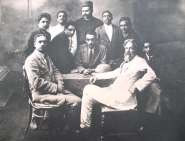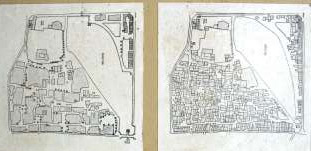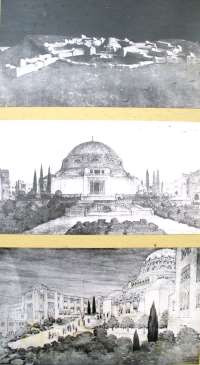GEDDES ABROAD
Geddes also travelled extensively. His Cities Exhibition toured to Paris, Dublin, Ghent and elsewhere; he visited Mexico and the United States; and worked in Cyprus, India, Palestine and later in Montpelier, France.
INDIA

Geddes went to India in 1915 with his Cities Exhibition at the invitation of Lord Pentland, Governor of Madras, for the purpose of re-planning Indian cities. He applied his method of ‘Conservative Surgery’ based on a ‘Diagnostic Survey’ which he had developed in Edinburgh’s Old Town. This was in contrast to the colonial policies of sweeping clearances carried out in the name of sanitation.

On the voyage the Clan Grant, carrying the Cities Exhibition, was sunk by enemy action. Geddes lost the fruit of twenty years labour and the core of a constantly evolving demonstration of his ideas. The replacement exhibition, assembled from material sent out by colleagues was more than a substitute however, since it revitalised his enthusiasm for the task ahead and allowed him to introduce new material specifically on India. Geddes had other work in hand as well. It was understood that he would advise on development schemes in a number of cities throughout the subcontinent. So many, in fact, that at one stage he reported having five, fair sized cities to cover in less than a fortnight. His approach was basically that of 30 years earlier in Edinburgh – “conservative surgery”. Opposing the rigid plans of colonial bureaucrats he embarked on diagnostic surveys plotting the layout and thoroughfares of the city before making his recommendations and then always taking cultural and historical factors into account. By allowing the city to “speak” to him his reports were usually sensitive to the needs of the people, and, furthermore, economical. His biological training was particularly useful with regard to questions of water supply and sanitation, one of the most urgent and intractable problems in a country beset by malaria. It has been suggested that Geddes was at his best in India probably because he felt that there was so much he could do both to realise his own ambitions and to improve the quality of life. He threw himself wholeheartedly into the work until a complete breakdown of his health in 1923 brought this phase of his career to an end.

PALESTINE
In 1919, Geddes was engaged to prepare a scheme for the Hebrew University of Jerusalem at the instigation of the psychoanalyst, Dr. David Eder, who headed the Zionist Organisation’s London Branch. Geddes saw the project as a golden opportunity to put his ideas about universities into practice. Working with his son-in-law, the architect Frank Mears, he submitted a preliminary report and masterplan to the Zionists before the end of the year. He also submitted a report on Jerusalem Actual and Possible to the Military Governor of Jerusalem in November 1919.
Frank Mears prepared a range of architectural drawings and watercolour perspectives of the Great Hall or ‘Dome of Synthesis’ which Geddes proposed as the central focus of the university, as well as other proposed buildings. These were widely used by the Zionist Organisation to promote the Hebrew University project in Europe and North America. Between 1925 and 1929, Frank Mears collaborated with the Jerusalem-based architect Benjamin Chaikin on designs for specific university buildings, but only the David Wolffsohn Library and the Einstein Institutes of Mathematics and Physics were ever completed as they had envisaged.
In 1925 Geddes submitted a report on town planning in Jaffa and Tel Aviv to the Municipality of Tel Aviv. His proposals were adopted and Tel Aviv is the only city whose core is entirely laid out according to a plan by Geddes.


